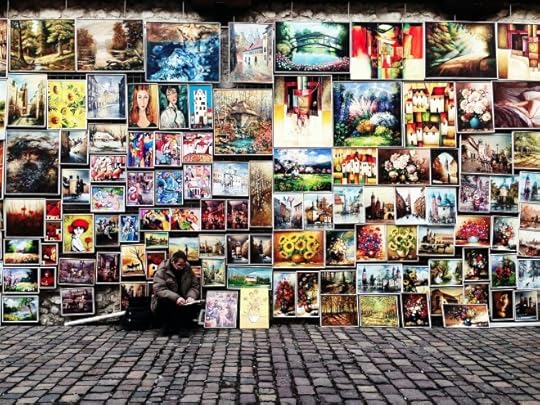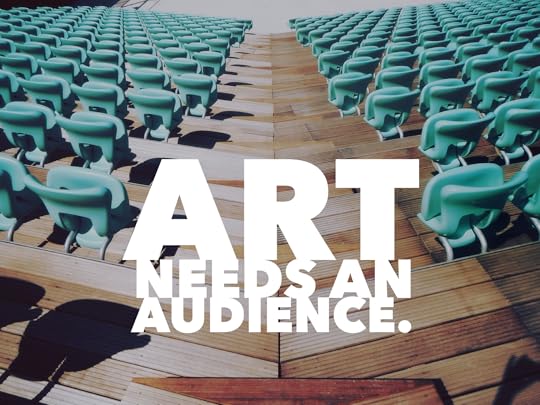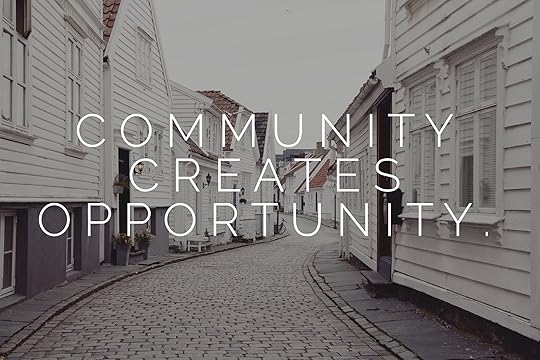Jeff Goins's Blog, page 49
September 23, 2015
074: Why Authentic Performances Steal the Show: Interview with Michael Port [Podcast]
Approximately 6,000 tweets are shared every second. Everyone is talking, but not everyone has something to say. If you want your message to make a difference, you need to know how to steal the show.

Michael Port, a New York Times best-selling author and inspiring speaker, trains anyone with a message to authentically present their best self in each performance of their life.
Often, we overshare in the name of authenticity while complaining that our voice can’t be heard amidst the noise. When we finally get the spotlight, we fall flat on our faces or tremble with fear. The good news is we don’t have to.
This week on The Portfolio Life, Michael and I talk about how to communicate better whether you’re standing on stage, recording a podcast, at a job interview, or presenting to your coworkers.
Listen in as we discuss the hazards of natural communicators and why the gift of gab is a curse.
Listen to the podcast
To listen to the show, click the player below (If you are reading this via email, please click here).
You can also listen via iTunes or on Stitcher.
Practice defines performance
When you start writing people may ask you to speak. I gave my first talk after becoming a blogger (because those are the same thing, right?) and thought “I’ll do this once. And if it goes well, I’ll do it again.”
In college I debated and did some stage acting so I felt like there was some performance experience to fall back on in delivering this presentation.
After preparing my slides the night before, I stood on stage and delivered a 90-minute talk that was supposed to fit in an hour slot. Fortunately, I got some laughs and a few people came up to thank me at the end.
However, I went back and watched the video a few months afterwards. It was horrible. It was painful to watch and it went on for way too long. A performance often feels different than it looks in front of people.
One of the things I found most interesting from the conversation with Michael is that a great performer is rarely the most entertaining. It’s good to make your audience laugh, but you have to give them something more.
Bonus: Download the full transcript here.
Show highlights
In this episode, we discuss:
One of the most powerful, creative tools
The first principle of performance
How the greatest performers in the world are the most authentic
Why the world doesn’t need to see every aspect of your life
The balance between authenticity and knowing what not to reveal
Deciding how you want to be known
One reason public speaking is intimidating to writers
How to avoid wasting your audience’s time
The worst way to reduce anxiety during a performance
What you must do after introducing an idea
Investing in the rehearsal process
Getting comfortable with discomfort
Understanding a bad choice is better than no choice
Quotes and Takeaways
“What we do today will lead us to where we are tomorrow.” —Michael Port
“We play roles all the time whether we realize it or not.” —Michael Port
“Self-expression comes from a deep sense of self-understanding.” —Michael Port
“Everything we do says something about us.” —Michael Port
“You can’t be a critic and a performer.” —Michael Port
“The big idea doesn’t have to be different to make a difference.” —Michael Port
Resources
Steal the Show by Michael Port
Seth Godin interview with Brian Koppleman on The Moment
Essentialism by Greg McKeown
Bonus: Download the full transcript here.
In what role are you trying to steal the show? How can you better prepare for the next performance? Share in the comments.

September 21, 2015
Art Needs an Audience (Why Art for Art’s Sake Doesn’t Work)
For ages, people have been debating the value of art. Should creativity be a vehicle for commerce, or something completely divorced from the marketplace? Is art for art’s sake a noble pursuit, or an exercise in vanity? The truth is a little more complicated.

Art for art’s sake was a creed of the 20th century bohemians, and on the surface, it sounds like a good idea. We should not create work that is function or commercial, the argument goes, but rather because it is a noble pursuit in itself. After all, what creative would confess to wanting to make as much money as possible off her art? That just sounds greedy.
But at the same time, what writer, designer, or musician wants to be irrelevant or ignored? Who really longs for their work to not be discovered? No, what we fear is that in somehow caring about marketing, we might lose the purity of the art. And that’s a valid concern, but not an entirely rational one.
We have, I think, this idea that the more impoverished and unpopular a creative person is, the better their work will be. But that’s a limiting belief. Sure, some artists were poor, but others were rich. Some were social outcasts and others were incredibly charismatic. In other words, there is no such thing as a typical artist.
Today, I hear more and more writers scorning the need to blog or tweet or build an email list. They want to avoid being “self-promotional.” But artists have always had to worry about how get their work to spread. That’s part of the job.
In 1872, George Sand, a French novelist, wrote that the artist has a “duty to find an adequate expression to convey it to as many souls as possible.” To put it more succinctly, art needs an audience.
“Art needs an audience.Jeff GoinsTweet thisTweet
Money is a means, not a master
Here’s the good news: you don’t have to become a sleazebag to be a successful artist. You don’t have to, as I think we all fear, sell out or starve. There is a middle ground in which you can use money to make art.
Here’s how Elizabeth Hyde Stevens, author of Make Money, Make Art: Lessons from Jim Henson on Fueling Your Creative Career, says it:
If we examine Henson’s work in earnest, we can find an inextricable quality running through it, a constant that we can rightly call character… Now, Jim Henson was always a willing participant in the marketplace, and as Malcolm Gladwell points out in The Tipping Point, Grover began as an IBM spokesman. Which is certainly true, and Rowlf the Dog did films for corporate meetings. He sold typewriters door-to-door in Henson’s early “meeting films,” a peculiar subgenre of the commercial designed for business-to-business sales pitches. It’s all there on YouTube.
Gladwell argues that “Sesame Street” was an extension of these commercials, but he’s got it the wrong way around. It’s the commercials that embody the ethos of “Sesame Street.” I laughed—forcefully, involuntarily and out loud—at one reel in which a character was shot at point blank because he said he didn’t use the product. Later, I couldn’t even remember the product’s name.
These works are not just making a buck for the buck’s sake. There’s a willfulness in them, a refusal to ever place the market’s demands above one’s own values.
In other words, money makes a better means than a master. Don’t give it too much importance in creative work. Sure, we need money to keep the lights on and buy supplies, but it’s not everything. As Steven Pressfield says, “Money buys you another season to create.” It gives you time, which gives you options.
“Money makes a better means than a master. Jeff GoinsTweet thisTweet
When you leverage the systems available to you to create enduring work, as Henson did, you create the kind of art that impacts a culture. You join the ranks of those who were able to change the world by being both creative and entrepreneurial.
It’s a challenge, of course, to be both a marketer and an artist, but one that many creatives are taking advantage of today. The opportunity to do creative work that also pays the bills is unprecedented with the access we have to tools and technology those before us have never had. To ignore this chance would do a disservice to their hard work. And as long as we leverage these tools in a way that doesn’t compromise our character, we honor their legacy.
Which brings us to an important subject: email lists.
3 reasons you should build an email list
It’s an odd transition to go from talking about Muppets to Mailchimp, but artists have always had to figure out how to get heard. And today, we have an incredible tool that many are still misusing or just not using at all.
I believe email marketing is the single best tool for an artist today. It is what TV was to Jim Henson and what movie theaters were to Walt Disney: an opportunity to be heard. My email list is my most important asset and most powerful creative tool (which was I decided to make some important changes to it recently).
So if you want to do creative work for a living and aren’t building an email list, you’re missing out. Here’s why:
An email list gives you permission. The hardest part of doing creative work is getting people to want to listen to you in the first place. When someone signs up for your email list, they’re giving you permission to communicate with them. That is incredibly powerful. You don’t have to wonder what people want to hear or if they’re going to censure you. In essence, you can say whatever you want. And if people stick around, you know your message is resonating. If not, they’ll tell you. It takes the guesswork out of figuring out “what the market wants.”
An email list gives you attention. Having an email list is like having your very own art museum where you control what work gets shown. It’s the best way to have the most control over who gets to hear what you have to say. You don’t have to worry about playing the political game of appeasing editors and performing for gatekeepers. You are now the gatekeeper. And of course, there is a tremendous amount of responsibility that comes with this, but you never have to worry about not being heard again.
An email list makes you money. We all know money isn’t everything, but it’s not nothing either (pardon the double negative). Money gives you freedom. And the verdict is in: the best way to make a living with your words is with an email list.
Of course, there are examples of writers and artists who succeed without an email list. But in my opinion, they are now the exception, not the rule. Having an email list not only gives you permission and attention, it gives you an advantage. You don’t have to wonder if people will listen to you, but when. It takes out all the guesswork.
So why would you even want to try doing creative work with your hands tied when you don’t have to?
For years, I avoided doing this, but when I finally got serious about growing my email list, everything changed. I reached more people, made more money, and got a better idea of what ideas were worth sharing with my audience.
Embracing the power of an email list will change your creative career forever. I promise. That’s why I’m hosting a free online workshop on list-building tomorrow (Tuesday) with my friend Bryan Harris.
Bryan knows more about this stuff than anyone I know. He’s the guy that I go to when I want to grow my list. Together, we’re going to share with you something special we’ve been cooking up for a while and how you can start growing your list fast today.
Resources
Weekend at Kermie’s
Make Art Make Money
Why You Should Start Building Your Email List Now
5 Ways to Build a Powerful Email List
Free Email List-building Workshop
Try Aweber Email Marketing for 30 Days
Giveaway: James Patterson’s Writing Course

Do you think art needs an audience, or is art for art’s sake enough? Share in the comments.

September 16, 2015
073: The Best Authors Never Write Alone: Interview with Steven Pressfield and Shawn Coyne [Podcast]
Instant access to a wealth of information and digital tools broke down the walls of traditional publishing. The good news is anyone can write a book. This is also the bad news.
The Internet provides the means for anyone to write, market, and launch their own book. Anyone who thinks they are a writer can self-publish a mediocre title with relative ease.
People who fool themselves into believing they’ve found a secret hack to writing success are cheating. And in the long run, cheaters never win.
You wouldn’t want a neurosurgeon who cheated off his classmates to operate on you. Nor do you want to read a book written by someone who disrespects the craft.
There are no shortcuts to becoming a writer.
This week on The Portfolio Life, Steven Pressfield, Shawn Coyne and I talk about the Resistance, what it’s like to write a New York Times bestseller, why rejection is healthy, and how we can find meaning and direction in our work as authors.
Listen in as we discuss the origin of The War of Art, why the ease of digital publishing is dangerous, and interesting aspects of the writer-editor relationship.
Listen to the podcast
To listen to the show, click the player below (If you are reading this via email, please click here).
You can also listen via iTunes or on Stitcher.
The priceless quality of an incredible editor
The Art of Work, is outperforming all of my previous books combined. The reason is simple. I found a great editor who helped me understand my own ideas with better clarity and context.
I’ve talked before about the key to building your tribe revolving around the concept of finding the “sweet spot”. The intersection of your passion and skill with what the market values.
While writing The Art of Work, I was passionate about the topic and skilled in the concepts. My editor helped me distill the message so it resonated with readers. We make a great team.
One of the things I found most interesting about Steven and Shawn is their authenticity with each other and their audience. They are not afraid to challenge conventional thinking and share their “secrets” with whoever will listen.
“The more we can teach each other… the better we’re going to be inspired to innovate and make better stories.” —Shawn Coyne
Show highlights
In this episode, we discuss:
The self-destructive nature of writers
Why an editor is instrumental in crafting a significant book
How writers self-sabotage their greatest work
Understanding the tension between what you want to write and what the reader values
Focusing on a target market and branching out from there
The genius behind giving away 10,000 copies of your book
Navigating the tension between showing up for your muse and applying proven formulas
Why not chasing the New York Times best-seller status is a brilliant move
Three simple tenants of launching an indie publisher
The myth of the Internet as a magic tool
What it means to be a “working writer”
Making your analytical and creative side work together
How genre works to manage your audience’s expectations
Traditional publishing vs self-publishing
Quotes and Takeaways
”To learn your craft requires a lot of intense effort.” —Shawn Coyne
“Tension is part of the fun.” —Shawn Coyne
“A lot of times you don’t even know who your market is.” — Steven Pressfield
“I always get up in the morning and grind it out every day.” —Steven Pressfield
“You have to pay your dues.” —Steven Pressfield
Failure helps you hone your craft.
Resources
The Story Grid: What Good Editors Know by Shawn Coyne
The War of Art by Steven Pressfield
The Authentic Swing by Steven Pressfield
The Lion’s Gate by Steven Pressfield
The Art of Work by Jeff Goins
Bonus: Download the full transcript here.
Who is your creative partner in crime? How would an editor challenge you in your craft? Share in the comments

073: Why the Best Authors Never Write Books Alone: Interview with Steven Pressfield and Shawn Coyne [Podcast]
Instant access to a wealth of information and digital tools broke down the walls of traditional publishing. The good news is anyone can write a book. This is also the bad news.
The Internet provides the means for anyone to write, market, and launch their own book. Anyone who thinks they are a writer can self-publish a mediocre title with relative ease.
People who fool themselves into believing they’ve found a secret hack to writing success are cheating. And in the long run, cheaters never win.
You wouldn’t want a neurosurgeon who cheated off his classmates to operate on you. Nor do you want to read a book written by someone who disrespects the craft.
There are no shortcuts to becoming a writer.
This week on The Portfolio Life, Steven Pressfield, Shawn Coyne and I talk about the Resistance, what it’s like to write a New York Times bestseller, why rejection is healthy, and how we can find meaning and direction in our work as authors.
Listen in as we discuss the origin of The War of Art, why the ease of digital publishing is dangerous, and interesting aspects of the writer-editor relationship.
Listen to the podcast
To listen to the show, click the player below (If you are reading this via email, please click here).
You can also listen via iTunes or on Stitcher.
The priceless quality of an incredible editor
The Art of Work, is outperforming all of my previous books combined. The reason is simple. I found a great editor who helped me understand my own ideas with better clarity and context.
I’ve talked before about the key to building your tribe revolving around the concept of finding the “sweet spot”. The intersection of your passion and skill with what the market values.
While writing The Art of Work, I was passionate about the topic and skilled in the concepts. My editor helped me distill the message so it resonated with readers. We make a great team.
One of the things I found most interesting about Steven and Shawn is their authenticity with each other and their audience. They are not afraid to challenge conventional thinking and share their “secrets” with whoever will listen.
“The more we can teach each other… the better we’re going to be inspired to innovate and make better stories.” —Shawn Coyne
Show highlights
In this episode, we discuss:
The self-destructive nature of writers
Why an editor is instrumental in crafting a significant book
How writers self-sabotage their greatest work
Understanding the tension between what you want to write and what the reader values
Focusing on a target market and branching out from there
The genius behind giving away 10,000 copies of your book
Navigating the tension between showing up for your muse and applying proven formulas
Why not chasing the New York Times best-seller status is a brilliant move
Three simple tenants of launching an indie publisher
The myth of the Internet as a magic tool
What it means to be a “working writer”
Making your analytical and creative side work together
How genre works to manage your audience’s expectations
Traditional publishing vs self-publishing
Quotes and Takeaways
”To learn your craft requires a lot of intense effort.” —Shawn Coyne
“Tension is part of the fun.” —Shawn Coyne
“A lot of times you don’t even know who your market is.” — Steven Pressfield
“I always get up in the morning and grind it out every day.” —Steven Pressfield
“You have to pay your dues.” —Steven Pressfield
Failure helps you hone your craft.
Resources
The Story Grid: What Good Editors Know by Shawn Coyne
The War of Art by Steven Pressfield
The Authentic Swing by Steven Pressfield
The Lion’s Gate by Steven Pressfield
The Art of Work by Jeff Goins
Bonus: Download the full transcript here.
Who is your creative partner in crime? How would an editor challenge you in your craft? Share in the comments

September 15, 2015
When Friends Die: The Clarity & Confusion of Grief
Two people I knew died this past week. I feel compelled to clarify these were people I met first online and then in real life. But then again, that happens to be just about everyone I know these days.

The first news came several days ago when I received an email from the leader of one of my online mastermind groups, with the subject line: “Brian and his family might be dead.” It was 4:30 in the afternoon. I ignored the email.
That evening, just before my son’s bedtime, I gave in to the nasty habit of checking email when I wasn’t supposed to be working and saw a long string of replies to that first email. That’s weird, I thought. All this for something that was surely a joke.
It wasn’t a joke. Brian and his family were all dead. And sadly, we would soon find out that the cause for what the police called an “apparent murder-suicide” was our friend. Brian killed his family. And then he killed himself.
I knew Brian. Not well, but I had met him before. We chatted about life and business and even shared about our families. He was a nice guy. So how does any of this make sense?
It doesn’t.
A few days later, another member of that same small group of entrepreneurs sent a followup email saying, “The bad news keeps coming: Scott Dinsmore passed away yesterday climbing Kilimanjaro.” This time, I didn’t ignore it. It was true. Scott, another friend from the Internet, had died.
He was on month eight of a year-long, around-the-world adventure with his wife Chelsea. He had just written a blog post announcing he was taking some time to disconnect from technology to be fully present to this adventure he was living.
“Death is still an enemy”
Brian was in his late 40s. Scott was 32. Neither should have died, if you can ever say someone “should” die. And the truth is I don’t know how to process this. I’m feeling a bit numb, I guess, about the whole thing. It doesn’t seem real.
Brian, in the time that I knew him, was always smiling. He was quiet and pensive, more reserved than many members in the group that we both belonged to. To me, he seemed sensitive, like someone would rather listen than talk your ear off. From what I could tell, he was a happy person.
Scott was gregarious. In the words of a friend, he was a “Bro,” a jock who belonged to all the right clubs and sports in high school. But beneath that bravado was someone who was inquisitive and curious and surprisingly humble. He always had more questions than answers. He believed anything was possible and could never wipe that sometimes-ridiculous smile off his face. I liked Scott.
At this point, I am supposed to tell you that some good has come from all this tragedy. But I don’t think that’s fair, and it may not even be true. All too often, I think, we try to glorify death, try to minimize its destructive effects on our lives and pretend that it doesn’t wound us so.
But that is not how you grieve. And that is not how you heal.
I remember once at a funeral, my old pastor was eulogizing his mother-in-law and said the Bible said death was the last enemy to be defeated, “but death is still an enemy.” Those words give me comfort now when I don’t know what I should be feeling. There’s something important, I suppose, in having an antagonist in any great story. It helps you remember that what you’re fighting for is worth the battle. Without an enemy, it’s hard to know what’s really at stake.
The confusion
The first time I experienced death in a very personal way, was when I was a Junior in high school. Doug, one of the most popular kids in my class, suddenly collapsed on the gym floor and died.
We were not close friends, but we had known each other since we were kids. It’s a strange feeling when someone you know dies, especially when that someone seems untouchable, a person to whom nothing bad could ever happen. That was Doug. Tall and blonde and always dressed in Abercrombie and Fitch with his hair perfectly styled, he was who every girl wanted and who every guy wanted to be.
When he died, my friends and I didn’t know what to do. We didn’t celebrate his death as some who had their own wounds to deal with, did And we didn’t spend days crying uncontrollably or sulking through the halls of the school, as his friends understandably did. We were caught somewhere in the middle. We knew this death mattered, but we didn’t know what to do with it.
And that’s often the worst part of grief: the confusion.
We weren’t going to pretend we knew Doug better than we did. That seemed dishonest. But neither could we just go on with life as if nothing had happened. We knew something did. And it was weighing on us, even if we weren’t quite sure what “it” was.
So we went bowling. Just to get out of the house, we’d call up several people and go bowl two or three games, eat nachos, and hang out. We didn’t talk about Doug, didn’t talk about much at all, and certainly didn’t try to comfort one another. We just stayed in each other’s company, which may be the greatest comfort of all.
Years later, I would learn of the ancient rite of shiva, a Jewish custom in which the members of a community sit together with those who are grieving. The point, as far as I understand it, is not to say nice things about someone you didn’t know, eat a casserole, and leave before you miss the evening news. It’s to be together. For a full week, your family and friends sit with you.
That’s what we, a group of nominal Protestants, were doing in the bowling alley three times a week. We were sitting shiva.
The clarity
Some time around then, another person I knew died. It was an old friend’s brother. He died in a horrible car accident, and the rumor around town was drugs were involved. A month or so later, the second of three brothers took his own life. The family was devastated.
My friend and I were no longer close, so it felt weird when my dad suggested we walk across town to give our condolences. I didn’t want to go. “That’s just what you do,” he said. When we knocked on the door, I wasn’t sure what we would say. How could we comfort this woman who had experienced such profound loss?
As my friend’s mom opened the door, my dad started talking from somewhere inside him I didn’t know existed. The piece of the monologue that I will never forget was:
You know, God is our Father. And when one of his children dies, it grieves him. He is grieving with us.
It wasn’t preachy or condemning or anything like that. The woman nodded and said thank-you, and we turned around and walked home. And that was it. I don’t remember us attending church in those days, but I do remember never having felt more proud of my dad.
When someone we know dies, we want to try to understand why, and that desire can create a lot of confusion. But there is a comfort in knowing that when you lose someone, in spite of what you feel, you are not alone.
For me, it helps to remember that death is an enemy, and that every great story has one. But that does not make death great or even good. Of course, there are some who will try to explain away the sadness with pictures of loved ones “looking down on us as angels from above.” And that may or may not be true.
But death is still an enemy.
There are others who would convinced us that we are all just soup and these silly emotions we feel when someone transitions from one state of being to another is our un-evolved consciousness playing tricks on us. And that may or may not be true. But death is still an enemy.
Recently, I reread a book from my childhood called The Bridge of San Luis Rey by Thornton Wilder. The book is about a bridge that collapses in Peru in the 18th Century, randomly killing five people. The tragedy is witnessed by a monk who was just about to step out onto the bridge and is left wondering, as we all tend to do when bad things happen: Was there some purpose behind this, or was it all an accident?
The truth is always more complicated. The narrator concludes:
But soon we shall die and all memory of these five will have left the earth, and we ourselves shall be loved for a while and forgotten. But the love will have been enough; all those impulses of love return to the love that made them. Even memory is not necessary for love. There is a land of the living and a land of the dead, and the bridge is love, the only survival, the only meaning.
Last night, I heard that TED.com decided to feature Scott Dinsmore’s talk on finding work you love on their homepage later this week. This was a dream of Scott’s and the result of his fans petitioning in light of his untimely death. So I suppose you could say that good things do come from bad and that life can spring from death. But I wish you could have one without the other.
More on grief
Scott Dinsmore I will Miss You Forever
Scott Dinsmore, I Miss You Deeply
Two Good Friends
When an Internet Friend Dies

September 14, 2015
Why I’m Killing My Email List and Changing Everything
I’m killing my email newsletter and resurrecting it as something I can be proud of. Why am I doing this? Because I can’t think of an unselfish reason not to do it.

Photo Credit: virtualwayfarer via Compfight cc
Emailing you whenever I want helps me. It gets me in your inbox more often, allows me to express myself more frequently, and lets me sell you things. None of those are necessarily bad reasons, but they aren’t very compelling, are they?
So I’m changing everything. And here are my promises to you:
I will respect your permission and try to share useful content. Once a week, I’ll send a newsletter of the latest from me. And whenever I have really big news (like a new course, free webinar, a book), I’ll send more than one weekly email.
I will spend an entire week writing my best content and deliver it to you every Monday along with other useful links and resources. My goal will be fewer, better messages.
I will give my best to the community and try to give more than I take as much as possible.
All of this is subject to change, of course, but I promise to tell you before I make any changes. I’m going to continue to blog when I have something to say (probably 2-3 times per week), but I’m also going to spend more time writing for other blogs and magazines, as that was how I got my start.
Getting back to my roots
This really goes back to my roots of blogging. I launched this blog, creating content for it every day for an entire year. Halfway through the first year, I started an email list. Since I was already writing seven blog posts a week, I wondered what value I could add to a newsletter.
So every Sunday morning, I’d wake up early and write an original thought on writing, influence, or creativity that I’d share with the tribe. People loved it. But as I became a dad and life got busier (and I got better about boundaries on the weekend), I decided to streamline everything. I stopped blogging as much and started sending an email newsletter with the blog post to everyone.
Suddenly, some weekly subscribers were getting three emails per week. I did this, quite frankly, because I had no margin to write a newsletter on a Sunday morning. Since so many wanted links to my newsletters, it just made sense to blog it.
But the Internet changed, and people are now busier than ever. And unless you’re a news site (or Seth Godin), it’s hard to get away with sending an email to your list every day. Of course, some people are doing this, and that’s fine. I’ve heard quite clearly from my readers than anything more than twice a week sounds like noise.
So I’m listening and taking action.
Content isn’t king (the audience is)
When I tested this idea with some readers on Twitter just to see what they thought, I didn’t hear any objections. There was nobody saying, “I want you to send me more email.” Some were saying twice a week and some said once, but nobody said, “You’re sending me three emails, but I’d love eight.”
Nobody. That spoke to me.
So I decided to change everything, because I couldn’t find a good reason to not at least try it. And the more I thought about it, the more excited I got. What if sending fewer emails gave me more time to create higher quality content? What if it allowed me to connect at a deeper level with my tribe? What if this bought me some margin to work on my next book?
Giving myself permission to break this unspoken rule started to excite me. And in that respect, I think it’s a win/win. But honestly, even if it was just a win for you, the reader, that’s reason enough to do it. Often, I think marketers get selfish about the way they interface with their audience, without acknowledging that they are in this very position because of their audience. That seems wrong.
Don’t misunderstand. I’m not a doormat, and I do have boundaries. I can’t promise I’ll reply to every email or read every 50,000-word manuscript people send me. But I got into a bad habit of making decisions without first considering what effect they would have on my audience.
Now, I’m trying to get back to the center.
Three core values of this community
Along those lines, I’ve chosen three core values that will guide this blog and community moving forward. They are:
Connection over interruption. Every time I send an email or post content, I’ll ask myself, “Do I have the right to share this? Does this help connect readers with something that helps them?” If not, I won’t share it.
Quality over frequency. Instead of running my mouth every time I have something to say, I pledge to only publish my best work when it is both interesting and helpful.
Impact over profit. In any business, there are always more opportunities to maximize profit. But that’s never been very motivating to me. So I’m recalibrating my business to focus more on the people that run it (i.e. my team) and make it possible to continue (the community, i.e. you).
Personally, I plan to model these myself. But I hope that you, as a member of this community, will consider joining me. I’m excited about the opportunities to invest more time into creating video content, writing elsewhere, and doing other fun things.
If this resonates, maybe you should consider changing something that you thought could never change. This isn’t just a nice idea. It’s a smarter way to market your work. I’m convinced of it. And maybe it’s a smart move for you, too, if you’re in the business of building an audience.
My hypothesis is this will increase open rates, increase trust with readers, and decrease the amount unsubscribes. But those reasons aside, it feels like I’m taking better care of my community, which is a reward in itself.
Free resources and giveaways
If you haven’t downloaded my eBook, “The Beginner’s Guide to Building an Audience” you should get it. It will get you started on your journey of earning the attention your work deserves.
This week, I’m giving away a Kindle HDX (thanks to BookGrabbr who is also giving away 1000 copies of my book You Are a Writer this week).
If you’re looking to get started with an email marketing platform, check out my guide to building an email list. I also recommend using Aweber to manage your email lists and contacts.
What change could you make to focus on building connection and community? Share in the comments.

September 10, 2015
072: The Rebirth of Renaissance Thinking and Modern Day Polymaths [Podcast]
Many people recognize Leonardo da Vinci as the quintessential Renaissance man. He was a painter, sculptor, architect, inventor, scientist, and musician. Leonardo remains a historical figure because he chose mastery of more than one skill. What if you face the same choice?
You are not stuck on an assembly line. You have varied interests, talents, education, and skills. The trick is to find where a few key elements intersect and empower you to become more than a jack-of-all-trades, but a master of some.
This week on The Portfolio Life, Andy and I talk about the resurgence of polymaths and what it means for creatives. Listen in as we discuss why every entrepreneur ought to think like a polymath.
Listen to the podcast
To listen to the show, click the player below (If you are reading this via email, please click here).
You can also listen via iTunes or on Stitcher.
Follow what fascinates you
If you’re finding yourself struggling with mastering one skill, you may need to develop a few complementary skills. There are opportunity costs in tackling three things versus one thing every day. But if you pick the right few things to do, the results far outweigh the costs.
I am a writer who uses technology and business to spread ideas. Those three areas: creativity, technology, and business, work together to establish the portfolio life not unlike the polymaths of the Renaissance.
Technology (and marketing) take the form of blogging, and social media, and podcasting. The business side involves making things sustainable so that I can make a living and enjoy the freedom to be more creative, write books, and try new things.
I’m not a master of these skills, but their combination creates something unique from what other people do, which causes the work to stand out.
There are complementary areas of interests that can strengthen your existing skills if only you just give yourself permission to do more than one thing.
You might just find that you end up doing that one thing much better when you begin borrowing from other disciplines.
BONUS: Download the full transcript here.
Show highlights
In this episode, Andy and I discuss:
Redefining mastery and how your craft is not just one thing
Why mastering a solitary skill is outdated
The forgotten versatility of Leonardo da Vinci
What it means to be a polymath
Fearing the challenge of multiplying mastery
A secret of “full-time” writers
Discovering a hidden energy in task switching
What the Teenage Mutant Ninja Turtles have in common with a rich and influential family of bankers
A new area of skill I want to explore
Quotes and Takeaways
Give yourself permission to do more than one thing.
Complementary areas of interest can strengthen your existing skill set.
Follow what fascinates you within self-imposed limitations.
Forget about mastery. Widen your reach.
When you are unique, you give people something to talk about.
Resources
The Medici Effect by Frans Johansson
Business Brilliant by Lewis Schiff
Designing Your Own Apprenticeship: How to Build a Team of Mentors
BONUS: Download the full transcript here.What will the world miss out on if you stay stuck in your one area of interest? How are you a polymath? Share in the comments

September 8, 2015
Designing Your Own Apprenticeship: How to Build a Team of Mentors
Recently, a friend wrote a book about how she’s always longed to go to Paris but finally resigned herself to the fact that she won’t. And she’s okay with that. Because Paris, for my friend, is not something out there. It’s what’s right in front of her.
I love that. She’s given up on the veneer of a life captured on Instagram and rejected the promise of fulfillment a city can bring. Instead, she’s embracing the life she has to live right now and discovering some extraordinary lessons in the process.
For some reason, I couldn’t help but think about my recent post on Medium on networks and how Hemingway’s move to Paris changed his life and career. But for every Hemingway in Paris, there’s a Bronte in rural Haworth.
As I’ve said before, creative success does not happen in isolation. So what network did the Bronte sisters have access to, living in rural England in the 1850s? Certainly not the host of influential artists and authors Hemingway had in Paris in the 1920s. What was the team of mentors that led to their inarguable contribution to the world of literature? Who did they?
Well, they had each other. And in light of my friend’s book, I am left wondering:
“What if the thing you’ve always wanted was actually right in front of you?Tweet thisTweet
The other weekend, I hosted a conference of 150 people from all over who had come together to learn how to build an audience around their messages. At the conference, we kept bringing up the metaphor of the “table.” For us, this meant the place where life is shared and lives are changed. We had people sit at round tables and told them to discuss each speech delivered from stage, sharing what they learned and helping one another apply the lessons.
One takeaway was the table you’re called to may not be a new network. Often, the place where breakthrough happens is the place you find yourself in right now. And that little idea changes everything.
Accidental apprenticeships
In the Middle Ages, we had a different way of getting experience and gaining access to networks.
Under the apprenticeship system, a person worked for free in exchange for an education. The student often lived in the same house as the teacher. This was the way a person became a professional — it was a totally immersive process — and it began as early as age twelve.
After completing the first stage of apprenticeship, the student, now called a “journeyman,” could venture out and travel to other cities for work. What a journeyman could not do, though, was take on apprentices. That right was reserved only for masters.
In many ways, a journeyman was still a student, though now able to be paid. To be a journeyman meant applying the techniques your teacher had passed down to see if they worked in the real world. It was a test, to see if you had what it took.
There was a certain amount of restlessness to being a journeyman. After a season of wandering, you had to submit a master work to the local guild and if they found it worthy, you were accepted in the guild, becoming a master. If not, you might have to wander forever.
How long do you think this process of apprenticeship took? How long to learn a new trade, practice it, and eventually earn the right to teach others?
A far cry from the modern two-month internship today, an apprenticeship took at least ten years. It was an excellent way of learning a skill under the guidance of someone wiser and more experienced. But in modern times, this ancient art of diving deep into a craft has but disappeared.
Now, the responsibility for reaching your potential is up to you.
This is more than a challenge; it’s a cruel taunt. Pulling ourselves up by our bootstraps can only take us so far, and despite what we’ve heard, there is no such thing as a self-made man or woman. We are all products of our environment, influenced by the people we encounter and the places we live. In other words, we need help. So how do we find it?
Finding your calling will not happen without the aid and assistance of others. Every story of success is, in fact, a story of community. Some people will help you willingly, while others may contribute to your education on accident. But if you are wise, you can use it all.
This is what I call an “accidental apprenticeship.” Here’s how it works.
Designing your own apprenticeship
Three years ago, three people I barely knew got together and decided they wanted to start a mastermind group. Each asked three other people, and that’s how the twelve of us started getting to meet every week. We’ve been doing it ever since.
Honestly, this was not the table I hoped to be invited to. I didn’t even know it existed. But this group has been the source of my greatest professional and personal growth in the past decade. Finding your own network may lead to a similar breakthrough. Just remember these three steps:
Decide what you want to learn. Try to get as specific as possible. Listen to your life and pay attention to what it says. Once you get clear on this, share it with people you know so that you can get connected to others who want similar things.
Identify a community you can learn from. Don’t look for a single mentor; look for a group of them. Most mentoring is not between individuals but amongst peers. Even in the Middle Ages, this was often the case. In the studio of a master, there were sometimes a dozen students all working together under the tutelage of a teacher but also learning from each other.
Use the collective resources of the group to help everyone reach their goals. If the group is not already meeting together, then it’s your job to call them together. Help everyone understand what each individual brings to the table and encourage them to share their talents.
This was what the Bronte sisters did for each other. They didn’t have access to the world’s greatest writing teachers, so they became the network they needed. They created their own group of mentors that would help them succeed, writing stories as little girls and sharing them with one another.
I think the lesson here is obvious: Don’t neglect the opportunity you have to create the network you need with the people who are already around you.
Don’t miss where you are right now
At the Tribe Conference, when we were saying goodbyes on the last day, I was happy to see people who sat together all weekend exchanging phone numbers and email addresses. They got it. Community creates opportunity. And if that’s true, then one of the best things we can do is create more communities.

Sometimes, I think, we get the wrong idea when we see people who succeed because of their network. We think the largest groups with access to the most important people are where growth happens. But often, success is the result of everyday effort multiplied by a small group of people.
We forget that when Hemingway went to Paris, the world didn’t yet know who Gertrude Stein or Ezra Pound was. James Joyce was only beginning his literary career. And Paris was just a cheap place to live.
When you think about your Paris, that place where your greatest growth happens, try to remind yourself that these places can happen anywhere — in the hustle and bustle of 1920s Paris, the rural farmland of 1850s England, and all points in between.
And as you consider who should be sitting at your table, that small group of people who will transform your life, remember these people do not have to be famous. They just have to be committed. What makes a group special is not the prestige of any single member but the collective wisdom it shares. This is where that old quote by Margaret Mead still rings true:
“Never doubt that a small group of thoughtful, committed citizens can change the world; indeed, it’s the only thing that ever has.Margaret MeadTweet thisTweet
When we gather around any given table, we create community. And we can always squeeze in one more chair. If you don’t have a seat yet, then you just might be the one who is supposed to call everyone together.
In case you missed our little gathering, here are some snapshots as told by the attendees themselves:
Sketchnotes from Tribe Conference 2015 by Matt Ragland
Tribe Conference by Ashley Espinoza
Masters in the Art of Caring by Jo Higgins Michael
Why I Left Tribe Conference in Tears by Haley McManigal
The Story of How I Got What I Wanted: A Seat at the Table by Brianna Lamberson
Where I’m From by Kate Spears
Find Your Tribe by Jeff & Julia Woods
I Went to a Writing Conference and I Left a Better Parent by Sarah Connatser
A Journey to Be! by Kathy Burrus
I Survived the Tribe Conference of 2015 by David Villalva
Resources
To read more about the Bronte sisters and how they helped each other become great writers, check out Bounce by Matthew Syed.
To learn more about accidental apprenticeships and how they work practically, listen to this podcast I did on apprenticeship.
To learn how to create your own mastermind group, listen to this podcast.
Want to dive deeper into this? Get my best-selling book The Art of Work plus $250 in bonuses including free videos and a workbook.
What’s one thing that you could do today to start creating the kind of community you need? Share in the comments.

September 3, 2015
071: Making Magic is Less Complicated Than You Think: Interview with Lee Cockerell [Podcast]
Disney theme parks are filled with magic. You can see it in the faces of every kid and kid at heart. But the secret to making Disney magic is not as mysterious as you might think.
It all comes down to people. By hiring the right people, Disney establishes a strong foundation of talented, passionate people who deliver a signature experience for their visitors. But a slow, intentional hiring process is only the beginning. There’s still training, culture creation, and taking risks.
Our guest today was the mastermind behind all of that for many, many years.
This week on The Portfolio Life, Lee Cockerell and I talk about his journey from working as a banquet waiter to ending his career as the Head of Operations for Disney theme parks in the U.S. Listen in as we talk about how Lee used a positive attitude and self-discipline to move forward in life.
Listen to the podcast
To listen to the show, click the player below (If you are reading this via email, please click here).
You can also listen via iTunes or on Stitcher.
Clarity is everything
Any parent knows the frustration of repeating yourself to your kids. Everything from cleaning their room, to remembering to flush the toilet, to keeping their elbows off the table. Retention requires repetition.
However, if your communication isn’t clear it doesn’t matter how often you repeat yourself. The same thing applies to our work.
At Disney theme parks you rarely see a confused guest. There are maps, signs, and cast members everywhere. Each attraction is clearly marked and guests know where to find food and fun. Clarity is key.
BONUS: Get the full interview transcript here.
Show highlights
In this episode, Lee and I discuss:
Starting a new job with zero experience
Launching a Disney Park in Paris without speaking French
The immeasurable benefits of traveling and living abroad
How changing your environment leads to person growth
Two essential characteristics of versatility
The detrimental impact of a bad attitude
Cultivating discipline as a competitive advantage
Creating a legacy of character
The positive correlation between hard work and satisfaction
Avoiding survival mode and the fear of getting stuck
An integral key to forging a successful career path
The courage to step up and take the risks
Intentionally spending time on activities that provide value
Three truths to unlocking time management magic
Big struggles of time management for teams
Clarity as the secret sauce
Quotes and Takeaways
”Do the hard things. It will make life easier for you.” —Lee Cockerell
“You don’t realize how much you don’t know until you get into a new situation” —Lee Cockerell
“If you have a good attitude and you’re organized, you can get by for a long time” —Lee Cockerell
“Learn to have resilience, be organized, and keep your promises.” —Lee Cockerell
“A life without risks is a shame. The fun is out there on the edge.” —Lee Cockerell
“Be a person who doesn’t have to know everything.” —Lee Cockerell
“Manage like a mother. They’re tough, but they’re looking out for you.” —Lee Cockerell
Resources
Creating Disney Magic podcast with Lee Cockerell and Jody Maberry
Creating Magic: 10 Common Sense Leadership Strategies from a Life at Disney by Lee Cockerell
The Customer Rules: The 39 Essential Rules for Delivering Sensational Service by Lee Cockerell
Time Management Magic: How To Get More Done Every Day And Move From Surviving To Thriving by Lee Cockerell
Thrive15.com (Use promo code “magic” for 30 days free)
BONUS: Get the full interview transcript here.What risks do you need to take? What hard work do you need to stick with to become better? Share in the comments

August 31, 2015
3 People Every Writer Needs in Their Creative Collective
Editor’s note: This is a guest post by Todd Henry. Todd is the author of the new book Louder Than Words: Harness The Power Of Your Authentic Voice, as well as The Accidental Creative and Die Empty. Find him at ToddHenry.com, or on Twitter.
When you imagine a person creating a work of art, what comes to mind?
Many of us think of a writer tucked away in the corner of a quiet room, a painter isolated in a smoldering attic loft, or a designer’s eyes fixed with precision on a laptop screen for hours on end, and we unwittingly internalize the myth that making art is a solo sport.
Yes, you must often do the work alone, but an artist is never truly alone. The artist’s sense of self, vision, and craft are often forged in the fires of community. Many of the most resonant, and ultimately impactful creative voices are honed through their interactions with others they respect and trust. As Virginia Woolf noted, “masterpieces are not single and solitary births; they are the outcome of many years of thinking in common, of thinking by the body of people, so that the experience of the mass is behind the single voice.”
To make art means to make bold, unique decisions in the face of uncertainty. Without a strong community around you, it’s easy to lose sight of who you are and what you care about, and over time your body of work becomes compromised via a series of seemingly inconsequential decisions. The courage to persist, and to ultimately build a body of work that reflects your unique passions and perspective, comes most readily from the people around you. Yes, you must be brave to do brilliant work, but you shouldn’t walk alone.
In Louder Than Words, I wrote about the importance of forming your “collective”, or a group of people who will help you stay inspired and hone your voice until it resonates deeply. There are a few kinds of people you should seek out as a part of your collective:
The Mirror
Who speaks unvarnished truth to you? You need someone in your life who will help you stay aligned and focused, and who will help you invest your finite creative resources in places that will reap the best return. A mirror reflects back the truth to you.
Who tells you things you don’t like now so that you can achieve results that you love later?
In isolation, you can start to want to be seen a certain way more than you want to actually be a certain way. This is a problem, because it means you are not operating from a place of authenticity, and your work will suffer. The mirror calls you on your nonsense, and helps you stay true to your compass, even when you are less than certain about the right path. Do you have someone who tells you the truth? If not, find them, because your voice isn’t just what you say, it’s how you are heard by others.
The Muse
Who fills your well? You need others in your life to inspire you and charge your creative batteries. Who plays this role? (And, on the other side of the equation, who do you play this role for?) Who introduces you to new ideas, shares inspiring resources with you, or pushes you to go into uncomfortable places with your art? You gain so much by seeing through the eyes of people you trust and respect.
A shallow response would be “I don’t need a muse. I have Facebook/Twitter/etc.!” Yes, these tools increase your awareness, but awareness is not the same as knowledge, and knowledge is not equivalent to wisdom. Conversations with your community will help you turn your insights into impact by creating accountability for you to take action. It’s action that defines reality, not knowledge. Inspiration has a shelf-life unless you act upon it.
The Mentor
Who is lighting your path? Not all the way down, but just for the next few steps? When doing creative work, it’s not important that you see the finish line, only the horizon. A mentor can shine the light a little ahead of you and help you see what’s coming next. Mentors don’t have to be a hundred steps down the path, only enough to give you perspective.
There have been many mentors in my life who have identified obvious problems, put books into my hands at just the right time, or helped me navigate a tricky decision. There wasn’t a formal “mentorship” agreement, we were just in community together and leaning on one another. What difficult problem are you facing right now that you need to seek help with? Don’t let today pass without taking action. Isolation due to pride or self-reliance can be the most damaging kind of all.
If you want to develop a resonant creative voice, you must lean into the power of community. Don’t allow the myth of the “lone wolf” creative to cause you to struggle in isolation. Form your collective, draw upon the wisdom and insight mirrors, muses, and mentors, and you’ll soon find that you’re doing the best work of your life.
Who is in your creative collective? Do you have a mirror, muse, and mentor? Share in the comments.









